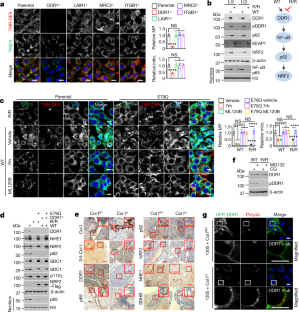膵管腺がん腫瘍のコラーゲンの質と混合物が、予後不良か非常に不良かを決定することを発見。 UC San Diego scientists find that quality and mix of collagen in pancreatic ductal adenocarcinoma tumors determines whether prognosis is poor or very poor
2022-10-05 カリフォルニア大学サンディエゴ校(UCSD)
膵管腺癌(PDAC)は、膵臓癌の中で最も一般的で、最も致死率の高い癌である。PDACの患者さんの全5年生存率はわずか7.1%です。
PDACの特徴は、腫瘍内の広範な腫瘍脱落または線維性結合組織であり、これは線維芽細胞およびそれらが分泌する細胞外マトリックスによる腫瘍塊への浸潤によって引き起こされるものである。マトリックスの主成分はI型コラーゲンまたはI型コラーゲン(Col 1)で、骨、皮膚、血管、結合組織の基本構造を形成するために体内で広く使われているタンパク質である。
Col 1がPDACの発生と治療反応に及ぼす影響については、研究者の間で激しい議論が交わされてきた。Col 1が腫瘍の成長と拡大を促進すると主張する研究者もいれば、腫瘍の成長を抑制し免疫攻撃から癌細胞を保護すると主張する研究者もいる。
2022年10月5日にNatureに掲載された新しい研究では、カリフォルニア大学サンディエゴ校医学部の薬理学および病理学の特別教授である上級著者Michael Karin博士の研究室のポスドクである共同筆者Hua Su博士と、南京大学医学部のBeicheng Sun医学博士と共同で研究する科学者Fei Yang博士は、腫瘍に存在するCol1の量ではなくその品質と性質が重要であることを示して、論争に決着をつけています。
具体的には、マトリックスメタロプロテアーゼ(コラーゲンなどのマトリックスタンパク質を分解する酵素)によって切断されたCol 1は腫瘍の成長を促進し、切断されていない無傷のCol 1は腫瘍の成長を阻害することを報告した。
<関連情報>
- https://today.ucsd.edu/story/survival-is-a-mixed-matter-for-deadliest-of-pancreatic-cancers
- https://www.nature.com/articles/s41586-022-05169-z
コラーゲン分解に依存するDDR1シグナルが膵臓がんの予後を規定する Collagenolysis-dependent DDR1 signalling dictates pancreatic cancer outcome
Hua Su,Fei Yang,Rao Fu,Brittney Trinh,Nina Sun,Junlai Liu,Avi Kumar,Jacopo Baglieri,Jeremy Siruno,Michelle Le,Yuhan Li,Stephen Dozier,Ajay Nair,Aveline Filliol,Nachanok Sinchai,Sara Brin Rosenthal,Jennifer Santini,Christian M. Metallo,Anthony Molina,Robert F. Schwabe,Andrew M. Lowy,David Brenner,Beicheng Sun & Michael Karin
Nature Published:05 October 2022
DOI:https://doi.org/10.1038/s41586-022-05169-z

Abstract
Pancreatic ductal adenocarcinoma (PDAC) is a highly desmoplastic, aggressive cancer that frequently progresses and spreads by metastasis to the liver1. Cancer-associated fibroblasts, the extracellular matrix and type I collagen (Col I) support2,3 or restrain the progression of PDAC and may impede blood supply and nutrient availability4. The dichotomous role of the stroma in PDAC, and the mechanisms through which it influences patient survival and enables desmoplastic cancers to escape nutrient limitation, remain poorly understood. Here we show that matrix-metalloprotease-cleaved Col I (cCol I) and intact Col I (iCol I) exert opposing effects on PDAC bioenergetics, macropinocytosis, tumour growth and metastasis. Whereas cCol I activates discoidin domain receptor 1 (DDR1)–NF-κB–p62–NRF2 signalling to promote the growth of PDAC, iCol I triggers the degradation of DDR1 and restrains the growth of PDAC. Patients whose tumours are enriched for iCol I and express low levels of DDR1 and NRF2 have improved median survival compared to those whose tumours have high levels of cCol I, DDR1 and NRF2. Inhibition of the DDR1-stimulated expression of NF-κB or mitochondrial biogenesis blocks tumorigenesis in wild-type mice, but not in mice that express MMP-resistant Col I. The diverse effects of the tumour stroma on the growth and metastasis of PDAC and on the survival of patients are mediated through the Col I–DDR1–NF-κB–NRF2 mitochondrial biogenesis pathway, and targeting components of this pathway could provide therapeutic opportunities.

